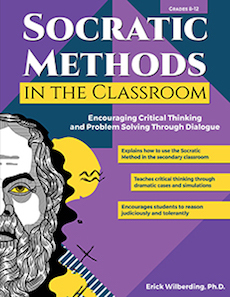Using Socratic Methods in the Classroom
Socratic Methods in the Classroom: Encountering Critical Thinking and Problem Solving through Dialog
By Erick Wilberding
(Prufrock Press, 2019 – Learn more)

Erick Wilberding’s Socratic Methods in the Classroom: Encountering Critical Thinking and Problem Solving through Dialog focuses on helping educators start using the Socratic Method in upper middle and high school.
Teaching through the Socratic Method can help students demonstrate their knowledge, consider other points of view, and reframe and refine their own thinking with a more critical and wide-lens perspective. The book includes a bevy of theories behind the practice and provides some templates and tips for educators to prepare to dive into this method.
A Template and Instructions

Theories
If you enjoy a historical perspective and a lot of theory, this book is for you. The author devotes one chapter to the philosophical and psychological underpinnings of critical thinking and a second chapter to the historical and contemporary views of the Socratic Method.
The second chapter concludes with Wilderding’s interpretation that the Socratic Method can, and should be, tailored to different knowledge domains because “Knowledge within different domains is constructed in different ways” (p. 17).
Wilderding supports his contention with ideas from religion, medicine, law, business, the humanities and sciences in high school and college. In Chapter 3, drawing from passages from Plato’s dialogues, the rationale for Maieutic Questioning (an expression derived from ancient Greece that basically means midwife questioning) is presented. Maieutic questioning “helps the other person give birth to his or her ideas” (p. 40).
Some good examples are provided, but it can be a bit difficult to get through the theory of ”why” and onto the more practical “how to.” The book is geared to the older student, grade 8 and above. From its description at the Prufrock website, a companion book by Wilberding, Teach Like Socrates, might be less theoretical.
Laurie Bobley is a former science teacher who has worked extensively with high needs populations in middle and high school. Currently, she is the Chairperson of a graduate-level teacher education program in New York City and is passionate about teacher development and children learning in the way that they learn best.

































